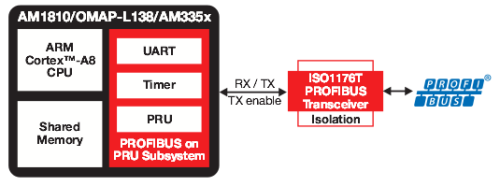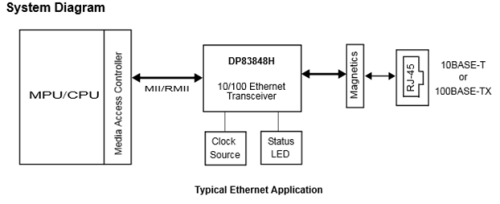The Industrial Ethernet solution from Texas Instruments is a unique combination of flexibility, performance, and optimized system cost. Designed to accommodate the evolving standards of real-time automation communication technology in harsh industrial environments, the platform features the Sitara™ AM335x ARM® Cortex™-A8 processor, the industry’s first fully-programmable ARM chip from a semiconductor vendor designed to handle multiple real-time communication protocols (EtherCAT, PROFIBUS and several others) on a single chip while offering the highest number of DMIPs per dollar. The solution also includes the EEE 1588 Precision Time Protocol 10/100 PHY and the Mini-Extreme Temperature 10/100 PHY.

Real-time Ethernet networks used in industrial settings differ from their office counterparts; they are built using durable components to withstand extreme temperatures, vibration, and humidity found in plant process areas, and must accommodate both future and legacy systems while providing enough security to eliminate unauthorized access. Very low-latency and real-time performance are key requirements in this application to be able to control and automate different components of an automation systems – HMI (Human Interface), PLC (Programmable Logic Controller) and various I/O devices such as sensors and Motor drives. This very low-latency requirement drives the need for an enhanced MAC layer on top of the standard Ethernet physical layer.
EtherCAT
EtherCAT, short for Ethernet for Control Automation Technology, is the latest standard of Ethernet systems; high performing and specifically optimized for use in an industrial setting. EtherCAT offsets the issue caused by an Ethernet's lack of efficiency for handling the small amount of data exchange typical of an automation network. Inefficient network performance is created because automation networks use a payload below the minimum requirement of an Ethernet frame, which forces the use of one frame per node per cycle, thus lowering bandwidth.
With the inclusion of EtherCAT technology, the network efficiency is no longer bottlenecked as certain features and configurations are forced upon the Ethernet, making it significantly more effective for handling the data exchange of automation networks, while maintaining Ethernet requirements.
Texas Instruments is the first semiconductor company in the world to license EtherCAT technology and integrate it into a processor, the Sitara AM335x ARM Cortex-A8 processor. The EtherCAT protocol is implemented with the help of a PRU (programmable real-time unit) subsystem being infused with the processor. This unique ARM+PRU architecture results in a high performance, power efficient core, at a very low system cost.

EtherCAT slave on a TI AM335x ARM microprocessor.
EtherCAT Standard Compliance
In recognition of successfully integrating EtherCAT technology on to the Sitara AM335x processor, Texas Instruments was awarded with the EtherCAT Conformance Test Certificate by the EtherCAT Technology Group, or ETG.
The ETG aims to ensure that usage of EtherCAT technology conforms to the correct EtherCAT specifications to guarantee interoperability between all devices outfitted with EtherCAT interfaces. As a result, all customers are obligated to verify their EtherCAT products regardless of private or public use.
TI's EtherCAT certification is a reassurance to all automation system developers that the Sitara AM335x processor meets industrial standards.
PROFIBUS
In addition to EtherCAT, TI’s Sitara AM335x ARM Cortex-A8 processor also provides an integrated PROFIBUS slave. Recall that PROFIBUS is the industrial standard for the Fieldbus protocol used in connecting to remote I/O units, sensors, actuators, and inter-networking components.
PROFIBUS reduces complexity and investment cost by joining a number of nodes through a single connection to increase communication effectiveness; as such, dedicated wiring to each node is no longer necessary.
Unlike the average solution where a microprocessor runs the PROFIBUS application level stack and then a separate external FPGA or ASIC implements the PROFIBUS protocol before an RS-485 transceiver connects to a physical layer, the integration of PROFIBUS into the AM335x processor bypasses the need for an FPGA or ASIC altogether as the processor is connected directly to the RS-485 transceiver.

TI's PROFIBUS solution.
IEEE 1588 Time Protocol PTP 10/100 PHY
Precision Time Protocol synchronizes clocks across a local area network with sub-microsecond accuracy and is an absolute necessity in any industrial Ethernet implementation. Included in TI’s solution suite is the DP83630 Precision PHYTER transceiver, supplying the IEEE 1588 PTP industry standard ― granting near wire timestamp precision.
Chiefly characteristic to the DP83630 is the combination of deterministic low latency, the freedom of selecting a microcontroller without any hardware customization, and state-of-the-art diagnostic features. At the disposal of system designers, these tools provide circumstance for accurately predicting faults through the dynamic monitoring of link quality during standard operation.
Mini-Extreme Temperature 10/100 PHY Ethernet Transceiver
Sustaining effective network function during harsh plant conditions requires heavy duty components such as the DP83848 PHYTER Mini Extreme. The miniature 6mmx6mm LLP 40-pin device is capable of withstanding temperatures ranging between -40° to 125°C while still maintaining reliable operation. It is an excellent solution for industrial and motor control, building/factory automation, and automotive and test equipment applications.
The DP83848 uses Auto-MDIX to attain superior performance above IEEE specifications. This removes cabling complications, produces ESD protection greater than 4KV HBM for heightened reliability, and enhances cable length operation to greater than 137 meters.
Translated to additional cost reduction, the DP83848's 25-MHz clock out abolishes the need for an extra Media Access Control clock source module.

A total industrial solution
At the heart of Texas Instruments’ solution set is a commitment to simplicity and flexibility — an aspiration to redefine industrial automation standards by breaking away from the practice of establishing applications through an assortment of external components. Flexible and durable multi-purpose equipment, scalability, and industrial hardware development tools all contribute to a more consolidated solution.
The Sitara AM335x processor as one example, removes the need for an external ASIC or FPGA. This effectively lowers the bill of material by more than 30 percent. Other key peripherals included on chip further boost this savings: CAN, ADC, USB + PHY, and two-port gigabit Ethernet with IEEE 1588 PTP standards.
The pin-to-pin and software compatibility of the Sitara AM335x processor allows the creation of multiple end equipments with devices to best fit the customer's industrial automation needs including: drives and I/O-level devices, Industrial PLC applications, and HMI products.
Lastly, paired with the Sitara AM335x processor is the AM3359 Industrial Communications Engine (ICE). The ICE is an industrial hardware development tools that enable customers to effortlessly include communication standards in to their industrial automations products. On the software end, developers have access to free industrial automation software complete with application notes and videos to simplify development.
Visit the Texas Instruments Solution Page for additional information.

Buy these parts now at Mouser Electronics:
Also see the recommended AM3357ZCZD72 on ti.com
![]()
Advertisement
Learn more about Texas Instruments





